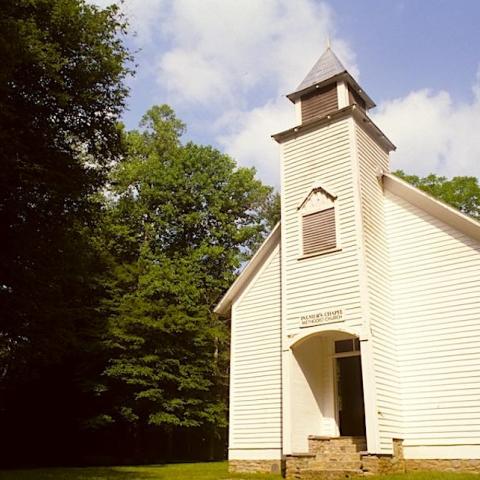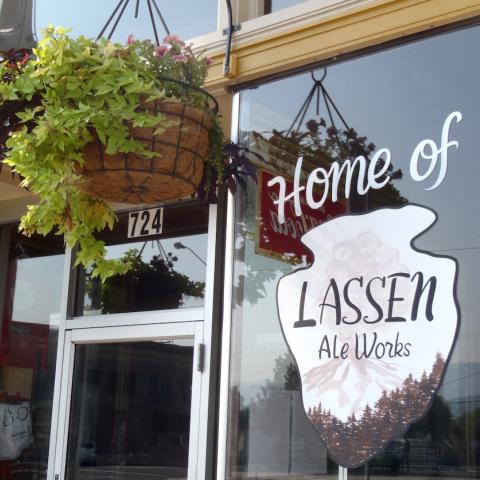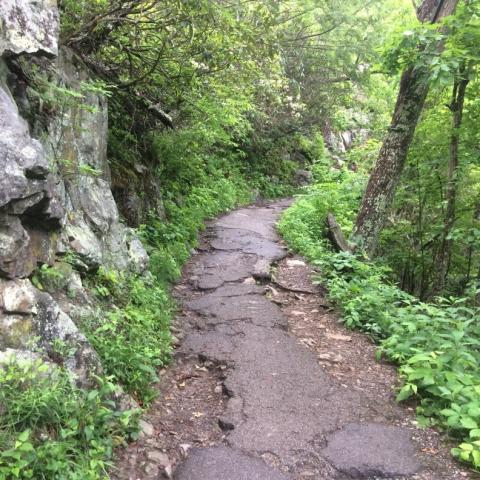
Great Smoky Mountains National Park staff is seeking public comment on a proposal to build a mountain bike course in the park/NPS file
A proposal to build a mountain bike trail network at Great Smoky Mountains National Park is being floated, one that could build nearly 13 miles of trail within a section of the Foothills Parkway transportation corridor that has not been developed.
Mountain bike enthusiasts long pushed to see more trails in national parks opened to their sport, but concerns over conflicts between mountain bikers and hikers have largely blocked those efforts.
The proposal at Great Smoky now open for public comment calls for bike-specific trails installed at the transportation corridor from Wears Valley to U.S. Highway 321, also known as the Gatlinburg Spur. Alternatives range from "stacked" trails aimed at different levels of mountain bikers with no trail access for hikers to one that would include 3.4 miles of trails open to hikers and birdwatchers.
In floating the proposal, park staff notes that "(W)hile more than 800 miles of trails exist in the Park, less than 8 miles are open to biking and there are no by-design mountain biking trails."
"The Foothills Parkway corridor, which is within the park’s transportation management zone and is not managed as wilderness, could provide visitors new opportunities to experience the park through mountain biking," the proposal said.
According to the MTB Project, which "showcases thousands of (mountain bike) trails in your own backyard," there are at least 70 miles of routes in or next to the national park open to mountain biking. The bulk of the mileage is on gravel roads.
Many more miles of trail can be found in the nearby Nantahala, Cherokee, and Pisgah national forests.
Public comment on the park's proposal is open through August 19. You can find details of the project and comment at this site.




 Support Essential Coverage of Essential Places
Support Essential Coverage of Essential Places







Comments
This artile is woefully mis-informed. Specificly when it says, "concerns over conflicts between mountain bikers and hikers have largely blocked those efforts". The fact is that over a decade ago, the method of sharing trails between hikers and bikers was codiefied in what we now call User Management Techniques. These techniques are used in urban trail systems that allow mountain bikes. The usage rates for urban trails are far in excess of any park usage rates.
What were you thinking??? Mountain biking and trail-building destroy wildlife habitat! Mountain biking is environmentally, socially, and medically destructive! There is no good reason to allow bicycles on any unpaved trail!
Bicycles should not be allowed in any natural area. They are inanimate objects and have no rights. There is also no right to mountain bike. That was settled in federal court in 1996: https://mjvande.info/mtb10.htm . It's dishonest of mountain bikers to say that they don't have access to trails closed to bikes. They have EXACTLY the same access as everyone else -- ON FOOT! Why isn't that good enough for mountain bikers? They are all capable of walking....
A favorite myth of mountain bikers is that mountain biking is no more harmful to wildlife, people, and the environment than hiking, and that science supports that view. Of course, it's not true. To settle the matter once and for all, I read all of the research they cited, and wrote a review of the research on mountain biking impacts (see https://mjvande.info/scb7.htm ). I found that of the seven studies they cited, (1) all were written by mountain bikers, and (2) in every case, the authors misinterpreted their own data, in order to come to the conclusion that they favored. They also studiously avoided mentioning another scientific study (Wisdom et al) which did not favor mountain biking, and came to the opposite conclusions.
Mountain bikers also love to build new trails - legally or illegally. Of course, trail-building destroys wildlife habitat - not just in the trail bed, but in a wide swath to both sides of the trail! E.g. grizzlies can hear a human from one mile away, and smell us from 5 miles away. Thus, a 10-mile trail represents 100 square miles of destroyed or degraded habitat, that animals are inhibited from using. Mountain biking, trail building, and trail maintenance all increase the number of people in the park, thereby preventing the animals' full use of their habitat. See https://mjvande.info/scb9.htm for details.
Mountain biking accelerates erosion, creates V-shaped ruts, kills small animals and plants on and next to the trail, drives wildlife and other trail users out of the area, and, worst of all, teaches kids that the rough treatment of nature is okay (it's NOT!). What's good about THAT?
To see exactly what harm mountain biking does to the land, watch this 5-minute video: http://vimeo.com/48784297.
In addition to all of this, it is extremely dangerous: https://mjvande.info/mtb_dangerous.htm .
For more information: https://mjvande.info/mtbfaq.htm .
The common thread among those who want more recreation in our parks is total ignorance about and disinterest in the wildlife whose homes these parks are. Yes, if humans are the only beings that matter, it is simply a conflict among humans (but even then, allowing bikes on trails harms the MAJORITY of park users -- hikers and equestrians -- who can no longer safely and peacefully enjoy their parks).
The parks aren't gymnasiums or racetracks or even human playgrounds. They are WILDLIFE HABITAT, which is precisely why they are attractive to humans. Activities such as mountain biking, that destroy habitat, violate the charter of the parks.
Even kayaking and rafting, which give humans access to the entirety of a water body, prevent the wildlife that live there from making full use of their habitat, and should not be allowed. Of course those who think that only humans matter won't understand what I am talking about -- an indication of the sad state of our culture and educational system.
I am an avid mountain biker, as well as a life long visitor and defender of National Parks. After looking at the proposed trails I was conflicted about pros and potential cons of developing trails in this small narrow section of GSMNP. After reading this article, and more specifically after reading your comment, I will now be fully supporting this project. Your extreme bias against against mountain biking, or any activity outside of your VERY narrow interpretation of what is considered "acceptable" use in National Parks is self evident, as is your disdain for mountain biking, kayaking, or seemingly any outdoor activity with any level of risk. You may want to look at the data as to how many hiking accidents, search and resue missions, auto accidents, and any number of other mishaps that occur in National Parks on a daily basis. As to some of your false claims: 1. I have ridden hundreds of miles of trails in dozens of areas throughout the US, and NEVER seen a single unauthorized and unmaintained trail created by mountain bikers. 2. Trails are are always designed specifically to minimize errosion, and are often closed during wet conditions to minimize damage. 3. I am constantly surrounded by wildlife on many of the trails I ride, and actually had a turkey walking in front of me on a steep climb a couple weeks ago. The point is, you have greatly overstated the negative impacts of mountain bike trails. My daughters grew up hiking in the Smokies, and we have routinely encountered bear, dear, turkey, and a plethora of other wildlife. I am adamant about preserving this for future generations, and would do nothing to jeopardize that. Having said that, there has always been debate between access to the masses and maintaining as much of a pristine environment as possible. This project involves a very narrow and small strip of land relative to the overall size of the park. With proper management, maintenance, I am not concerned about the impact to the park. I would even be for making the mountain bike trails a "fee area" to pay for maintenance and management. So, count me in. I will be lobying the NPS to move forward with this project, and in the process create a new crop of NP supporters.
I see more trash, destroyed vegetation, and all around bad behavior on footpaths in the Smokies than I've ever seen at the better maintained, cleaner, dual use trails around Knoxville.
We ought to ban humans from the park as well.